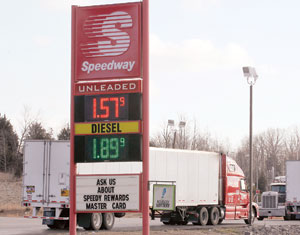Senior Reporter
Diesel Falls 6.5¢ to $2.112 for Tenth-Straight Decline
 John Sommers II for Transport Topics
John Sommers II for Transport TopicsThe U.S. average retail diesel price fell for the 10th consecutive week, dropping 6.5 cents a gallon to $2.112, the Department of Energy reported.
Trucking’s main fuel is 82.1 cents a gallon cheaper than a year ago and remains at its lowest level since March 23, 2009, when it was at $2.093, DOE said after its Jan. 18 survey of fueling stations.
Diesel fell in all regions of the United States, with the lowest average on the Gulf Coast, where it is down to $2.014 a gallon after a drop of 6.6 cents.
DOE also reported the average retail gasoline price fell 8.2 cents to $1.914. It is 15.2 cents cheaper than a year ago. Gasoline also declined in all U.S. regions, with the lowest price of $1.672 found also on the Gulf Coast.
Jeffery Born, a professor of finance at Northeastern University in Boston, told Transport Topics, “While diesel fuel prices in the U.S. have not declined as much as the price of crude oil over the past 12 months, neither have gasoline prices in many parts of the country. They did fall about 30% nationwide in 2015.”
Looking ahead this year, Born said, “It is unlikely that we see a similar decline in 2016, but I expect prices to decline for the first half of 2016, at a minimum.”
On Jan. 20, crude oil futures closed on the New York Mercantile Exchange at $26.56 a barrel, the lowest close since May 2003. On Jan. 20, 2014, crude oil futures were almost $20 higher and closed at $46.39.
Born said sluggish economic activity in China and Europe means that “international energy firms will look to push product toward the U.S. economy, which is much more robust.”
Denton Cinquegrana, an analyst with the Oil Price Information Service, said the average retail diesel price was lower than the average retail gasoline price in Alaska, California and Montana — and the two were even in Nevada — on Jan. 19.
Diesel is generally more costly than gasoline and, typically, demand for heating oil increases in the winter, which reduces the availability of the base stock they share. That has resulted traditionally in higher diesel prices, unlike the current situation.
“I think you’re going to see more and more of that happening, particularly in the spring and summer [when demand for gasoline goes up],” Cinquegrana said.
The International Energy Agency said last week that global oil markets could “drown in oversupply,” sending prices even lower as demand growth slows and Iran revives exports with the end of sanctions.
IEA trimmed 2016 estimates for global oil demand as China’s economic expansion weakens and raised forecasts for supplies outside the OPEC oil cartel.
While non-OPEC supply is set to drop 600,000 barrels a day in 2016, Iran’s comeback could fill that gap by the middle of the year, Bloomberg News reported. As a result, world markets may be left with a surplus of 1.5 million barrels a day in the first half.
“Concerns about excess supply continue to weigh on the market,” Gene McGillian, a senior analyst at Tradition Energy in Stamford, Connecticut, told Bloomberg. “We began last year with a multimonth string of huge inventory gains. It looks like we’re going to do the same this year, with the difference being that we’re already close to 80-year highs.”
Recently, the world’s two benchmark crude oils, Brent and West Texas Intermediate, have been converging in price.
Brent futures closed at $27.88 on Jan. 20, just $1.33 higher than WTI’s price on the same day.
OPIS’ Cinquegrana said part of the narrowing is because WTI is gaining wider distribution through an expanding infrastructure and exports, and that has put pressure on prices for Brent.
“Some of the supply bottlenecks for WTI have been alleviated over the last year or two,” Cinquegrana said.
He added there was little justification for one benchmark oil to go way above the other without some disruptive event.




